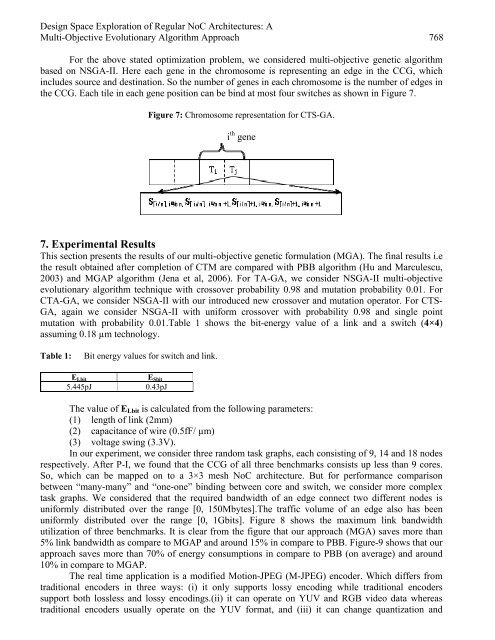European Journal of Scientific Research - EuroJournals
European Journal of Scientific Research - EuroJournals
European Journal of Scientific Research - EuroJournals
You also want an ePaper? Increase the reach of your titles
YUMPU automatically turns print PDFs into web optimized ePapers that Google loves.
Design Space Exploration <strong>of</strong> Regular NoC Architectures: A<br />
Multi-Objective Evolutionary Algorithm Approach 768<br />
For the above stated optimization problem, we considered multi-objective genetic algorithm<br />
based on NSGA-II. Here each gene in the chromosome is representing an edge in the CCG, which<br />
includes source and destination. So the number <strong>of</strong> genes in each chromosome is the number <strong>of</strong> edges in<br />
the CCG. Each tile in each gene position can be bind at most four switches as shown in Figure 7.<br />
Figure 7: Chromosome representation for CTS-GA.<br />
i th gene<br />
7. Experimental Results<br />
This section presents the results <strong>of</strong> our multi-objective genetic formulation (MGA). The final results i.e<br />
the result obtained after completion <strong>of</strong> CTM are compared with PBB algorithm (Hu and Marculescu,<br />
2003) and MGAP algorithm (Jena et al, 2006). For TA-GA, we consider NSGA-II multi-objective<br />
evolutionary algorithm technique with crossover probability 0.98 and mutation probability 0.01. For<br />
CTA-GA, we consider NSGA-II with our introduced new crossover and mutation operator. For CTS-<br />
GA, again we consider NSGA-II with uniform crossover with probability 0.98 and single point<br />
mutation with probability 0.01.Table 1 shows the bit-energy value <strong>of</strong> a link and a switch (4×4)<br />
assuming 0.18 µm technology.<br />
Table 1: Bit energy values for switch and link.<br />
ELbit<br />
ESbit<br />
5.445pJ 0.43pJ<br />
The value <strong>of</strong> ELbit is calculated from the following parameters:<br />
(1) length <strong>of</strong> link (2mm)<br />
(2) capacitance <strong>of</strong> wire (0.5fF/ µm)<br />
(3) voltage swing (3.3V).<br />
In our experiment, we consider three random task graphs, each consisting <strong>of</strong> 9, 14 and 18 nodes<br />
respectively. After P-I, we found that the CCG <strong>of</strong> all three benchmarks consists up less than 9 cores.<br />
So, which can be mapped on to a 3×3 mesh NoC architecture. But for performance comparison<br />
between “many-many” and “one-one” binding between core and switch, we consider more complex<br />
task graphs. We considered that the required bandwidth <strong>of</strong> an edge connect two different nodes is<br />
uniformly distributed over the range [0, 150Mbytes].The traffic volume <strong>of</strong> an edge also has been<br />
uniformly distributed over the range [0, 1Gbits]. Figure 8 shows the maximum link bandwidth<br />
utilization <strong>of</strong> three benchmarks. It is clear from the figure that our approach (MGA) saves more than<br />
5% link bandwidth as compare to MGAP and around 15% in compare to PBB. Figure-9 shows that our<br />
approach saves more than 70% <strong>of</strong> energy consumptions in compare to PBB (on average) and around<br />
10% in compare to MGAP.<br />
The real time application is a modified Motion-JPEG (M-JPEG) encoder. Which differs from<br />
traditional encoders in three ways: (i) it only supports lossy encoding while traditional encoders<br />
support both lossless and lossy encodings.(ii) it can operate on YUV and RGB video data whereas<br />
traditional encoders usually operate on the YUV format, and (iii) it can change quantization and

















